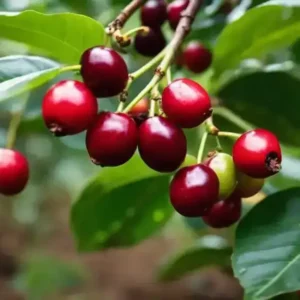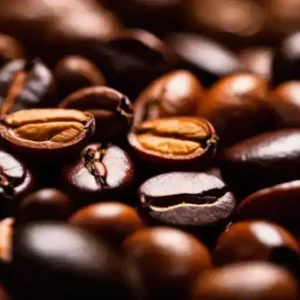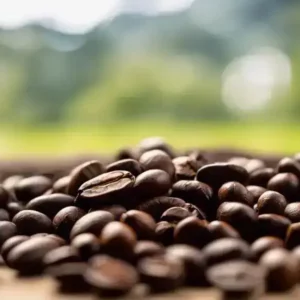In your coffee journey, knowing Arabica and Robusta distinctions is key. Arabica, grown at higher altitudes, delivers a smoother, milder taste loved by many. On the other hand, Robusta thrives in lower altitudes, boasting a stronger, more bitter flavor profile. While Arabica contains less caffeine, Robusta packs a punch in this department.
Understanding these differences can help you choose the coffee that suits your palate best. If you seek more insights into Arabica vs. Robusta, discovering the historical background, origin, physical characteristics, growing conditions, chemical composition, and market presence will deepen your understanding further.
As a coffee connoisseur with over a decade of experience in coffee cultivation and tasting, I am here to guide you through the intricate world of Arabica and Robusta coffee varieties.
Arabica vs Robusta: Historical Background and Origin
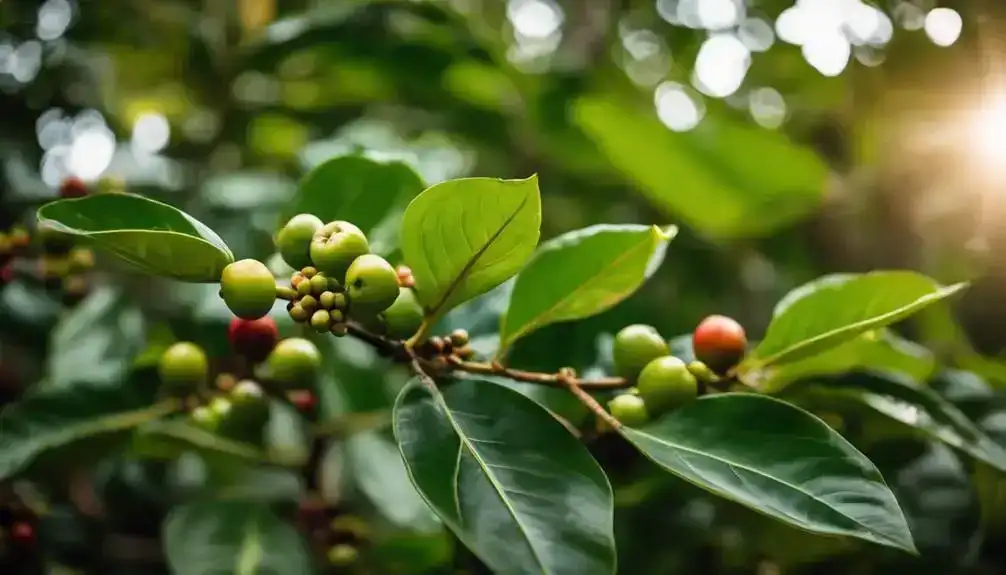
Arabica coffee, originating from Ethiopia, is known for its smooth, fruity flavors.
Robusta coffee, on the other hand, hails from lower altitudes and boasts a strong, bitter taste.
Understanding the historical background and origin of these two coffee varieties provides insight into their distinct characteristics and flavors.
Arabica Coffee
Arabica coffee has a rich historical background originating from Ethiopia’s high-altitude regions. This type of coffee requires specific conditions like high elevation and shade to thrive.
Due to its sensitivity and susceptibility to pests, cultivating Arabica plants can be more challenging compared to Robusta.
Historical Background
Frequently overlooked in the coffee world, the historical background of Arabica coffee reveals a rich and fascinating narrative of cultivation and trade. Arabica coffee holds immense historical significance, with its evolution over time deeply intertwined with cultural impact and regional influence.
Originating in Ethiopia, Arabica has shaped the global coffee industry with its delicate flavors and complex history, making it a premier choice for coffee enthusiasts worldwide.
Cultivation Requirements
When considering the cultivation requirements of Arabica coffee, it’s vital to understand its specific needs for best growth and production.
- Soil Composition: Arabica thrives in well-drained, fertile soil with a slightly acidic pH level.
- Irrigation: Consistent watering is essential, but over-watering can lead to root rot.
- Sunlight Exposure: Arabica plants prefer filtered sunlight and shade, making them suitable for cultivation under canopy trees.
Robusta Coffee
Robusta coffee, originating from the Coffea canephora plant, has a more robust nature compared to Arabica.
Robusta is known for its resilience, thriving at lower altitudes and being more resistant to diseases and pests.
Understanding the historical background and cultivation requirements of Robusta coffee provides insights into why it has become a popular choice in the global coffee market.
Historical Background
Originating from the Coffea canephora plant, Robusta coffee has a rich historical background that contrasts with its counterpart, Arabica coffee. Robusta’s evolution and trade routes have shaped its historical significance and cultural impact.
This robust coffee variety, known for its strong flavor and higher caffeine content, has found its place in various regions around the world, offering a bold alternative to the more delicate Arabica beans.
Cultivation Requirements
In order to cultivate robusta coffee successfully, you need to take into account its resilience to diseases and pests, as well as its ability to thrive in lower altitudes.
- Cultivation Techniques: Robusta requires less maintenance due to its natural resilience.
- Soil Composition: Well-drained, sandy soil is ideal for robusta cultivation.
- Pest Management: Robusta’s natural pest resistance reduces the need for chemical interventions.
Arabica vs Robusta: Physical Characteristics

When comparing Arabica and Robusta coffee, one noticeable difference lies in the physical characteristics of their beans. Arabica beans tend to have a more oval shape and are larger in size compared to the more compact and round Robusta beans. These variations in bean shape and size can impact the overall flavor and brewing characteristics of each coffee type.
| Bean Characteristics | Arabica | Robusta |
|---|---|---|
| Shape | Oval | Round |
| Size | Larger | Smaller |
| Color | Lighter | Darker |
| Density | Lower | Higher |
Bean Shape and Size
When comparing Arabica and Robusta coffee beans, one noticeable difference lies in their shape and size. Arabica beans tend to be larger and more elongated, while Robusta beans are smaller and rounder. This physical distinction can impact the overall flavor and aroma of the brewed coffee. Check out the table below for a visual comparison of Arabica and Robusta beans with respect to their shape and size.
| Characteristics | Arabica Beans | Robusta Beans |
|---|---|---|
| Size | Larger | Smaller |
| Shape | Elongated | Round |
| Color | Slightly lighter | Slightly darker |
| Aroma | Complex and nuanced | Strong and bold |
| Flavor | Smooth with hints of fruit | Bitter and intense |
Arabica Beans
The physical characteristics of Arabica beans, especially their bean shape and size, play a significant role in distinguishing them from Robusta coffee beans. Arabica beans are oval-shaped and larger compared to Robusta beans.
This influences the brewing process, as Arabica benefits from methods like pour-over or drip brewing to extract their nuanced flavors effectively.
Experimenting with different brewing techniques can enhance the rich taste of Arabica coffee.
Robusta Beans
Arabica beans are known for their distinct oval shape and larger size compared to Robusta beans, influencing the brewing process for each coffee variety.
Robusta benefits from its smaller, rounder shape, which can create a stronger brew.
When considering brewing techniques, Robusta’s compact size allows for a more concentrated flavor extraction, ideal for espresso lovers seeking a robust and intense coffee experience.
Arabica vs Robusta: Growing Conditions and Cultivation
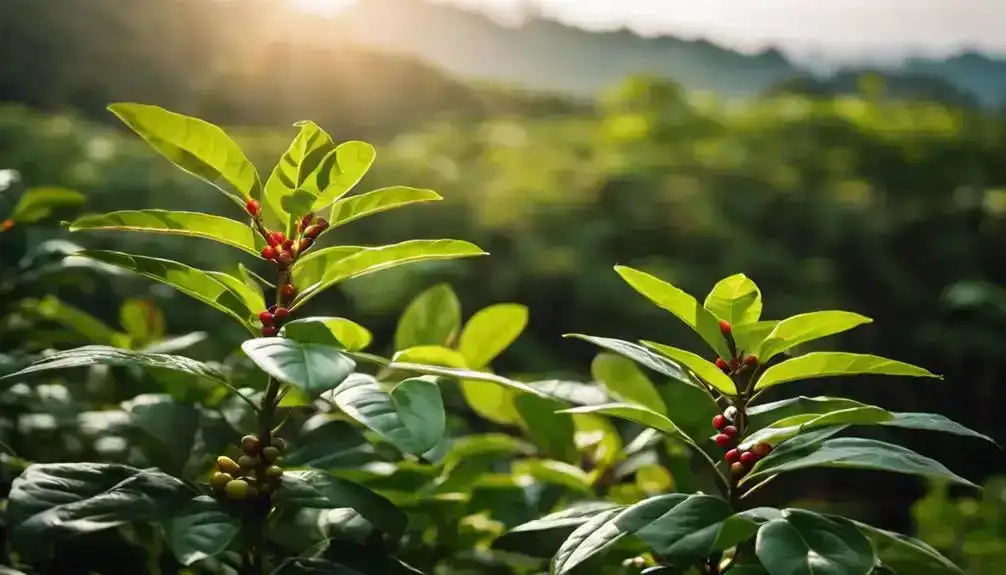
Arabica coffee thrives in high-altitude regions with specific climatic conditions, such as ample shade and a stable temperature range. It’s more sensitive to pests, making cultivation more challenging.
Robusta, on the other hand, is known for its resilience to diseases and pests, thriving at lower altitudes.
Altitude and Climate
When it comes to growing conditions, Arabica coffee thrives in high-altitude regions, requiring ample shade and stable temperatures. On the other hand, Robusta can be cultivated at lower altitudes and is known for its resilience to pests and diseases. Below is a table summarizing the key differences in the growing conditions for Arabica and Robusta coffee:
| Aspect | Arabica Growing Conditions | Robusta Growing Conditions |
|---|---|---|
| Altitude | High-altitude regions | Lower altitudes |
| Climate | Requires specific climatic conditions | More resilient to pests and diseases |
Arabica Growing Conditions
High elevation and specific climatic conditions are vital for cultivating Arabica coffee plants. Arabica thrives in rich, well-draining soil compositions and requires ample shade due to its sensitivity to direct sunlight.
The plants are also particular about temperature, preferring stable ranges for best growth. Harvest timing is essential for Arabica, as picking the beans at the right moment guarantees the best flavor development in the coffee.
Robusta Growing Conditions
For cultivating Robusta coffee plants, ensuring specific altitude and climate conditions is essential to their growth and development. Robusta thrives in lower altitudes ranging from sea level to about 800 meters, requiring well-drained, sandy loam soil conditions.
Unlike Arabica, Robusta prefers full sun exposure and is more tolerant of warmer temperatures. These plants are sturdy and can withstand harsher environments, making them easier to cultivate.
Resistance to Pests and Diseases
When it comes to resistance to pests and diseases, Arabica coffee plants are more susceptible, requiring careful attention to cultivation practices to prevent infestations. In contrast, Robusta coffee plants exhibit greater resilience, making them easier to grow and less prone to pest-related issues. Understanding these differences can help coffee growers choose the most suitable variety for their cultivation needs.
TABLE:
| Aspect | Arabica Coffee | Robusta Coffee |
|---|---|---|
| Pest Resistance | More susceptible to pests | More resilient to pests |
| Disease Resistance | Vulnerable to diseases | Stronger resistance to diseases |
Arabica’s Susceptibility
Have you ever wondered why Arabica coffee plants are more susceptible to pests and diseases compared to Robusta plants?
Arabica’s pest susceptibility and vulnerability to plant diseases stem from its delicate nature. The high-altitude, shade-loving Arabica plants require meticulous care, making them more prone to infestations and infections.
Understanding these factors is essential for successful Arabica cultivation and ensuring a healthy crop yield.
Robusta’s Resilience
Wonder why Robusta coffee plants excel in resisting pests and diseases compared to their Arabica counterparts?
Robusta’s versatility and boldness contribute to its sustainability and popularity.
These plants have a natural resilience to common coffee pests, making cultivation easier and more cost-effective.
Robusta’s robust nature allows it to thrive in various environments, making it a reliable choice for coffee producers looking for a hardy and resistant crop.
Arabica vs Robusta: Chemical Composition and Flavor Profile

Arabica and Robusta coffees differ in their chemical composition and flavor profile, influencing the taste and aroma of your brew.
Arabica beans have lower caffeine content but higher sugar and lipid levels, resulting in a sweeter and more complex flavor profile.
In contrast, Robusta beans contain more caffeine, contributing to their intense, bitter taste and robust nature.
Caffeine Content
When comparing Arabica and Robusta coffee, one significant difference lies in their caffeine content. Robusta beans contain almost twice as much caffeine as Arabica, impacting both the flavor and the plant’s robustness. Understanding this disparity is crucial in selecting the right coffee type tailored to your taste preferences.
| Arabica’s Caffeine Level | Robusta’s Caffeine Level |
|---|---|
| Lower caffeine content | Higher caffeine content |
Arabica’s Caffeine Level
How does the caffeine content in Arabica coffee compare to that of Robusta coffee?
Arabica’s caffeine content is lower than Robusta’s, resulting in a milder taste.
The reduced caffeine levels in Arabica beans contribute to their smoother and more nuanced flavor profile, often with hints of fruit and sugar.
This distinction makes Arabica a popular choice for those seeking a less intense coffee experience.
Robusta’s Caffeine Level
Robusta coffee boasts a noticeably higher caffeine content compared to Arabica, contributing to its bold and intense flavor profile. This caffeine comparison affects not only taste preferences but also energy levels and health effects.
The higher caffeine levels in Robusta can provide a stronger kick but may not be suitable for those sensitive to caffeine. Understanding these differences can help you choose the coffee that aligns best with your preferences and health considerations.
Sugar and Lipids
When comparing Arabica and Robusta coffee, understanding the differences in their sugar and lipid levels is essential. Arabica beans typically have higher sugar and lipid content, contributing to their sweeter and more complex flavor profiles. On the other hand, Robusta beans exhibit different levels of these components, influencing their distinct taste characteristics. To explore this further, take a look at the table below for a clear comparison between the two:
| Aspect | Arabica | Robusta |
|---|---|---|
| Sugar Content | Higher | Variable |
| Lipid Content | Higher | Variable |
Arabica’s Sugar and Lipid Levels
Arabica coffee stands out due to its higher levels of sugar and lipids, contributing markedly to its sweeter and more complex flavor profile compared to Robusta.
These nutrient levels in Arabica beans enhance the overall sweetness of the brew, creating a more nuanced taste experience for coffee enthusiasts.
The lipid content in Arabica adds to its rich mouthfeel, making it a popular choice for those who appreciate a well-rounded and flavorful cup.
Robusta’s Sugar and Lipid Levels
With higher sugar and lipid levels compared to its counterpart, Arabica, the chemical composition of Robusta coffee contributes to its distinct flavor profile.
Robusta’s higher lipid content gives it a richer mouthfeel and a more pronounced bitterness, while the increased sugar levels provide a sweeter taste.
These nutritional differences play a significant role in Robusta’s flavor profile analysis, enhancing its aromatic qualities and setting it apart from Arabica.
Flavor and Aroma
When it comes to coffee, the flavor and aroma play a significant role in distinguishing between Arabica and Robusta beans. Here’s a quick breakdown to help you understand the key differences:
- Arabica’s Flavor Profile
- Robusta’s Flavor Profile
Arabica’s Flavor Profile
Renowned for its smooth and complex flavors, Arabica coffee beans are celebrated for their nuanced taste profiles that often feature hints of fruit and sugar.
These flavor nuances can be revealed through different brewing techniques, allowing coffee enthusiasts to fully experience the rich aroma profiles and sensory delights that Arabica coffee has to offer.
Experimenting with various brewing methods can open up a world of diverse and satisfying coffee experiences.
Robusta’s Flavor Profile
To contrast with Arabica’s nuanced flavors, Robusta coffee beans are known for their strong and bitter taste profile, setting them apart in the world of coffee.
Robusta’s bitterness profile and flavor intensity create a bold and intense drinking experience, appealing to those who enjoy a more robust cup of coffee.
If you seek a potent kick and a pronounced taste in your brew, Robusta might be the perfect choice for you.
Acidity Levels in Arabica and Robusta Coffee
Comparing the acidity levels in Arabica and Robusta coffee reveals distinct differences in their chemical composition and overall flavor profile. When it comes to brewing techniques and flavor profiles, here are three key points to keep in mind:
- Acidity Comparison: Arabica coffee is known for its bright acidity, which is often described as higher and more essential than Robusta. This acidity adds a pleasant tangy or fruity flavor to Arabica brews, enhancing the overall taste experience.
- Flavor Profile: The acidity in Arabica coffee, when brewed correctly, can bring out floral, fruity, or wine-like notes. On the other hand, Robusta beans tend to have a lower acidity level, resulting in a more bitter and earthy taste profile. The acidity in coffee plays an important role in balancing the flavors and enhancing the overall aroma.
- Roasting Methods: The acidity levels in both Arabica and Robusta coffees can be influenced by the roasting process. Lighter roasts generally preserve the acidity levels better, while darker roasts tend to mellow out the acidity, resulting in a smoother and less acidic cup of coffee. Experimenting with different roasting methods can help you find the perfect balance of acidity in your coffee brew.
Arabica vs Robusta: Market Presence and Consumer Preferences
Arabica coffee holds the majority share in the global market, comprising 60-70% of coffee production worldwide. Its reputation for quality and nuanced flavors often leads to a higher price point compared to Robusta.
On the other hand, Robusta, making up 30-40% of the market, is favored for its strong taste and is commonly used in espresso blends and instant coffee due to its affordability and bold flavor profile.
Global Production and Market Share
When it comes to global coffee production and market share, Arabica coffee reigns supreme, representing around 60-70% of the world’s coffee output. On the other hand, Robusta holds its ground with a market presence of about 30-40%, commonly utilized in espresso blends and instant coffee products. Understanding the market dominance of Arabica and the steady presence of Robusta provides insight into consumer preferences and the dynamic coffee industry landscape.
| Market Presence | Arabica | Robusta |
|---|---|---|
| Global Share | 60-70% | 30-40% |
Arabica’s Market Dominance
With its dominant position in the global coffee market, Arabica coffee holds a significant share due to its superior quality and nuanced flavors.
Arabica’s global reach spans across various continents, with market trends showing a preference for its smooth taste and complex profiles.
Enjoyed by many, Arabica’s popularity continues to grow, solidifying its top status in the world of coffee.
Robusta’s Market Presence
In the global coffee market, Robusta asserts its presence through its distinct bold flavor and higher caffeine content, appealing to consumers seeking a stronger coffee experience.
Robusta’s unique qualities include a bitter taste and increased pest resistance.
The market demand for Robusta is driven by its affordability, making it a popular choice for espresso blends and instant coffee products.
Consumer Taste Preferences
When it comes to coffee, consumer preferences play a significant role in choosing between Arabica and Robusta. Here’s a quick look at what influences these preferences:
- Arabica: Known for its smooth, complex flavors and lower caffeine content, Arabica is favored by those who enjoy nuanced coffee experiences.
- Robusta: With its strong, bitter taste and higher caffeine levels, Robusta appeals to coffee drinkers seeking a bold flavor and extra kick.
- Personal Taste: Ultimately, the decision between Arabica and Robusta boils down to individual taste preferences, shaping the coffee industry’s diverse offerings.
Preference for Arabica
Arabica coffee stands out in the market due to its nuanced flavors and popularity among coffee enthusiasts. With benefits such as lower caffeine content and higher sugar and lipid content, Arabica beans offer a sweeter and more complex taste profile.
This variety dominates global coffee production, accounting for about 60-70% of the market. Its cultivation requires specific conditions like high elevation and ample shade, contributing to its premium quality.
Preference for Robusta
Robusta coffee, contrasting with Arabica in market presence and consumer preferences, is favored for its bold flavors and suitability for specific coffee blends.
Robusta beans contain almost twice as much caffeine as Arabica, contributing to their strong, bitter taste. This makes Robusta a popular choice in espresso blends and instant coffee products, appealing to those who enjoy a more robust and intense coffee experience.
Arabica vs Robusta: Applications in Coffee Products

When it comes to coffee products, Arabica and Robusta serve distinct purposes. Arabica is commonly used in specialty blends and high-end coffee products due to its nuanced flavors, while Robusta finds its place in espresso blends for creating rich crema and in instant coffee for its bold taste.
Understanding the unique applications of each type can help you choose the right coffee product that aligns with your taste preferences and brewing needs.
Use in Espresso and Instant Coffee
When it comes to espresso and instant coffee, Arabica and Robusta play distinct roles based on their unique characteristics.
Here’s how each type contributes to these popular coffee products:
- Arabica beans are often preferred for espresso due to their nuanced flavors and smoother profiles.
- Robusta, with its bold and strong taste, is commonly used in instant coffee for a more intense flavor experience.
- Understanding the roles each type plays can help you choose the right coffee product that suits your taste preferences.
Arabica’s Role
Arabica coffee’s versatility shines through its widespread use in espresso blends and instant coffee products due to its nuanced flavor profiles and quality.
With Arabica’s benefits like smoother taste and complex flavors, it’s a top choice for those seeking a refined coffee experience.
Whether you enjoy a rich espresso or a quick instant coffee, Arabica’s versatility guarantees a delightful cup tailored to your preferences.
Robusta’s Role
Robusta coffee’s robust nature and high caffeine content make it a popular choice for creating espresso blends and instant coffee products. It offers a bold and intense flavor profile compared to its Arabica counterpart.
The strong taste of Robusta enhances the crema in espresso blends and provides a powerful kick in instant coffee blends. Its resilience to pests and diseases also makes it a cost-effective option for coffee production.
Blends and Specialty Coffees
When it comes to coffee blends and specialty coffees, understanding the distinctions between Arabica and Robusta is essential. Each type brings unique characteristics to the table, influencing the final flavor and experience of the blend.
Here are three key points to keep in mind:
- Arabica-Based Blends: Known for their nuanced flavors and complexity, Arabica beans are often used in specialty coffee blends to enhance the overall taste profile.
- Robusta-Based Blends: Robusta’s bold and strong flavor makes it a popular choice for creating blends that require a more intense coffee experience.
- Balancing Act: Finding the right blend of Arabica and Robusta is an art, as it involves mixing these beans in varying ratios to achieve the desired taste and characteristics in the final product.
Arabica-Based Blends
In coffee blends and specialty coffees, the unique characteristics of Arabica beans shine through, offering a premium flavor experience that caters to discerning coffee enthusiasts.
Arabica-based blends are known for their smooth, complex flavor profiles with hints of fruit and sugar, achieved through specific roasting techniques.
These beans are favored in brewing methods that highlight nuanced tastes, aligning well with diverse taste preferences in the coffee world.
Robusta-Based Blends
For crafting blends and specialty coffees, consider utilizing the unique characteristics of Arabica and Robusta beans to cater to a diverse range of coffee preferences.
Experiment with flavor combinations to create robusta blends that offer a balance of strength and complexity.
Explore different brewing techniques to enhance the bold flavors of Robusta beans, providing a rich and intense coffee experience that appeals to those seeking a robusta-centric taste profile.
Arabica vs Robusta in Coffee Making

When it comes to coffee making, understanding the differences between Arabica and Robusta beans is key. Your choice of bean can greatly impact the flavor and quality of your brew.
Whether you prefer exploring blends or savoring single origins, knowing the characteristics of Arabica and Robusta can elevate your coffee experience.
Choosing Your Bean: A Guide for Coffee Lovers
When choosing between Arabica and Robusta for your coffee brewing, understanding the unique qualities each bean brings to your cup becomes crucial.
To make an informed decision, consider the best brewing methods for Arabica and how to maximize Robusta’s potential in your coffee experience.
Explore the following key points to enhance your coffee-making journey:
- The Best Brewing Methods for Arabica
- Maximizing Robusta’s Potential in Your Cup
The Best Brewing Methods for Arabica
Discover the best brewing methods to bring out the rich and complex flavors of Arabica coffee.
For an invigorating option, try cold brew for a smooth and less acidic taste.
Alternatively, explore the nuanced flavors through pour-over techniques, allowing you to control the brewing process for a customized cup.
Experiment with these methods to enhance your Arabica coffee experience and savor its unique characteristics.
Maximizing Robusta’s Potential in Your Cup
To fully maximize Robusta’s potential in your cup, focus on highlighting its bold and robust flavors through suitable brewing methods. Experiment with different brewing techniques to enhance Robusta’s strong taste profile.
Consider combining Robusta with other flavors to create unique and satisfying coffee blends. By exploring various Robusta enhancements and flavor combinations, you can tailor your coffee experience to match your preferences and enjoy a robust cup every time.
Blends and Single Origins: Exploring the Possibilities
When it comes to coffee making, blending Arabica and Robusta opens up a world of possibilities. Single-origin coffees also offer a chance to savor the purest flavors each bean has to offer.
Here are three key points to ponder in the art of blending and exploring single origins:
- The Art of Blending: Combining Arabica and Robusta beans can create a unique flavor profile that balances the nuances of Arabica with the strength of Robusta.
- Single Origin Magic: Enjoying single-origin coffees allows you to experience the distinct flavors and characteristics of beans grown in a specific region.
- Crafting Your Brew: Experimenting with different blends and single origins can help you tailor your coffee experience to suit your taste preferences and discover new favorites.
The Art of Blending: Combining Arabica and Robusta
Blending Arabica and Robusta coffee beans offers a unique opportunity to create complex flavors and enhance the overall coffee experience. By utilizing specific blending techniques and carefully balancing flavors, roasters can create a harmonious combination of the smooth nuances of Arabica with the bold strength of Robusta.
Through varying roasting profiles, the aroma development in these blends can offer a rich and diverse sensory experience for coffee enthusiasts seeking a dynamic cup.
Single Origin Magic: Savoring the Purest Flavors
Explore the distinct characteristics of Arabica and Robusta coffee in single origin brews, revealing a world of pure flavors and unique experiences.
Arabica beans offer smoother, fruity tasting notes, while Robusta brings a stronger, more bitter flavor profile.
Experiment with different brewing techniques to extract the full potential of each bean type, enhancing your coffee experience with nuanced flavors and rich aromas.
Price Comparison: Arabica vs Robusta
When comparing Arabica and Robusta coffee prices, several factors come into play. Arabica coffee often costs more due to its cultivation requirements, including high elevation and susceptibility to pests, making it a more labor-intensive crop to grow.
The unique flavor profiles and higher quality associated with Arabica beans also contribute to their higher price point in the market.
Factors Affecting Coffee Prices
Factors such as the specific qualities, market demand, and production costs play a significant role in determining the price difference between Arabica and Robusta coffee beans.
Here are three key elements that impact coffee prices:
- Market Fluctuations: The ever-changing supply and demand dynamics in the global coffee market directly influence the prices of Arabica and Robusta beans. Factors like weather conditions, political instability in coffee-producing regions, and shifts in consumer preferences can lead to price volatility.
- Sustainability Initiatives: The growing emphasis on sustainability in coffee production, including fair trade practices, organic certifications, and eco-friendly farming methods, can affect the prices of Arabica and Robusta beans. Consumers willing to pay a premium for sustainably sourced coffee can drive prices up.
- Trade Agreements: International trade agreements and tariffs between coffee-producing and consuming countries can impact the cost of Arabica and Robusta beans. Trade policies, import/export regulations, and currency exchange rates all play a role in determining the final price of these coffee varieties.
Understanding these factors can provide insight into the fluctuating prices of Arabica and Robusta coffee.
Why Arabica Often Costs More
The price disparity between Arabica and Robusta coffee beans can be attributed to several factors, with Arabica often commanding a higher price in the market. Here are three reasons why Arabica beans are generally more expensive:
- Higher Production Costs: Arabica coffee is typically grown at higher altitudes, which require more labor-intensive cultivation practices. The need for specific climate conditions and the susceptibility of Arabica plants to pests result in increased production costs compared to Robusta.
- Quality Perception: Arabica is widely regarded as superior in quality compared to Robusta due to its smoother flavor profile and nuanced taste. This perception drives higher demand for Arabica beans, allowing producers to set higher prices in the market.
- Market Dynamics: The dominance of Arabica in the specialty coffee market contributes to its premium pricing. With a higher market presence and consumer preference for Arabica’s flavor characteristics, the demand-supply dynamics often lead to Arabica beans being priced at a premium compared to Robusta.
Understanding these coffee bean economics and market pricing dynamics sheds light on why Arabica often comes with a higher price tag.
Conclusion
To sum up, have you discovered which coffee variety suits your taste buds – the smooth sweetness of Arabica or the bold bitterness of Robusta?
Understanding the key differences between these two popular coffee types can enhance your coffee experience. From caffeine levels to flavor profiles, each variety offers a unique taste that caters to different preferences.
So, next time you sip your favorite brew, consider the nuances of Arabica vs. Robusta and savor the complexity of your coffee choice.




